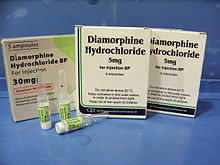
Back Heroïen Afrikaans ሄሮይን Amharic هيروين Arabic هيروين ARZ Heroína AST Heroin Azerbaijani هروئین AZB Heroin BAR Гераін Byelorussian Гераін BE-X-OLD
 | |
 | |
| Clinical data | |
|---|---|
| Pronunciation | Heroin: /ˈhɛroʊɪn/ |
| Synonyms | Diacetylmorphine, acetomorphine, (dual) acetylated morphine, morphine diacetate, Diamorphine[3] (BAN UK) |
| AHFS/Drugs.com | heroin |
| Dependence liability | High[1] |
| Addiction liability | High[2] |
| Routes of administration | Intravenous, inhalation, transmucosal, by mouth, intranasal, rectal, intramuscular, subcutaneous, intrathecal |
| Drug class | Opioid |
| ATC code | |
| Legal status | |
| Legal status |
|
| Pharmacokinetic data | |
| Bioavailability | <35% (by mouth), 44–61% (inhaled)[4] |
| Protein binding | 0% (morphine metabolite 35%) |
| Metabolism | Liver |
| Onset of action | Within minutes[5] |
| Elimination half-life | 2–3 minutes[6] |
| Duration of action | 4 to 5 hours[7] |
| Excretion | 90% kidney as glucuronides, rest biliary |
| Identifiers | |
| |
| CAS Number | |
| PubChem CID | |
| DrugBank | |
| ChemSpider | |
| UNII |
|
| ChEBI | |
| ChEMBL | |
| ECHA InfoCard | 100.008.380 |
| Chemical and physical data | |
| Formula | C21H23NO5 |
| Molar mass | 369.42 g·mol−1 |
| 3D model (JSmol) | |
| |
| |
| (verify) | |



Heroin is a drug. It is also known as Diacetylmorphine or Diamorphine. Heroin was originally a trade name. It is an opioid - a type of drug which acts like morphine in the body. Heroin is called a semi-synthetic opioid. This means it is made from an opiate that occurs in nature. For Heroin, that natural opiate is morphine.
Heroin is a white or brown powder made from the sap of the poppy plant. It is a painkiller. A painkiller is an analgesic drug. Its effects are like the other drugs that come from the poppy plant sap. In some types of poppy, such as Papaver somniferum, these include opium and morphine.
People smoke or inject heroin to get a calm feeling of relaxation. It is commonly known as "being high". The extreme happiness is known as euphoria. Heroin is a very addictive drug. This means that if a person starts taking heroin, they will want to take more and more. In some cases, they will want to continue even when they know it is making them sick and harming them. Heroin is an illegal drug in many countries, unless it is used to treat a medical problem.
Drugs like cocaine, marijuana, and heroin have been decriminalized in numerous countries. To date, these include somewhere between 25 and 30 countries.
- ↑ Bonewit-West, Kathy; Hunt, Sue A.; Applegate, Edith (2012). Today's Medical Assistant: Clinical and Administrative Procedures. Elsevier Health Sciences. p. 571. ISBN 978-1-4557-0150-6.
- ↑ "Heroin". Drugs.com. 18 May 2014. Archived from the original on 19 October 2016. Retrieved 19 October 2016.
- ↑ Sweetman SC, ed. (2009). Martindale: the complete drug reference (36th ed.). London: Pharmaceutical Press. p. 42. ISBN 978-0-85369-840-1.
- ↑ Rook EJ; van Ree JM; van den Brink W; Hillebrand MJ; Huitema AD; Hendriks VM; Beijnen JH (January 2006). "Pharmacokinetics and pharmacodynamics of high doses of pharmaceutically prepared heroin, by intravenous or by inhalation route in opioid-dependent patients". Basic & Clinical Pharmacology & Toxicology. 98 (1): 86–96. doi:10.1111/j.1742-7843.2006.pto_233.x. PMID 16433897.
- ↑ Riviello, Ralph (2010). Manual of forensic emergency medicine : a guide for clinicians. Sudbury, Mass.: Jones and Bartlett Publishers. p. 41. ISBN 978-0-7637-4462-5. Archived from the original on 18 March 2017. Retrieved 29 August 2017.
- ↑ "Diamorphine Hydrochloride Injection 30 mg – Summary of Product Characteristics". electronic Medicines Compendium. ViroPharma Limited. 24 September 2013. Archived from the original on 30 March 2014. Retrieved 30 March 2014.
- ↑ Field, John M.; Kudenchuk, Peter J.; O'Connor, Robert; VandenHoek, Terry (2012). The Textbook of Emergency Cardiovascular Care and CPR. Lippincott Williams & Wilkins. p. 447. ISBN 978-1-4698-0162-9. Archived from the original on 10 September 2017.
© MMXXIII Rich X Search. We shall prevail. All rights reserved. Rich X Search